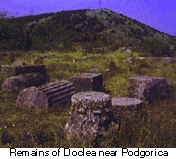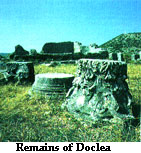Montenegro

Nemanjics' period (1186-1353)
After Bodin's death, the infighting among his potential successors weakened the Doclean state and brought about Raska's reign. Between 1183 and 1186, relying on the domestic feudal lords who betrayed the state interest, the Great Raska's chieftain Stefan Nemanja, conquered Zeta and ended the first period of the Montenegrin state.

 With
the conquest of Duklja / Zeta, as it was referred to from the 11th century,
Nemanja is said to have destroyed entire coastal towns, (except Kotor),
that never subsequently recovered. In the tide of destruction Nemanja also
had destroyed 'monuments of Latin literacy by burning local churches and
books. It is claimed that he also persecuted the Bogomils, and expelled
the Greeks from Zeta'(Rovinski, Crna Gora u proslosti i sadasnjosti,
Cetinje, 1993, p.279).
With
the conquest of Duklja / Zeta, as it was referred to from the 11th century,
Nemanja is said to have destroyed entire coastal towns, (except Kotor),
that never subsequently recovered. In the tide of destruction Nemanja also
had destroyed 'monuments of Latin literacy by burning local churches and
books. It is claimed that he also persecuted the Bogomils, and expelled
the Greeks from Zeta'(Rovinski, Crna Gora u proslosti i sadasnjosti,
Cetinje, 1993, p.279).
The Duklja/Zeta destruction was accompanied with the forceful conversion of Zeta's population to Orthodox Christianity. In 1185, the Bar's archbishop Grgur, escaped Nemanja's reprisal, which, factually and formally, ended the existence of Archdiocese in Bar.

 In
1190, Nemanja's son Vukan, the first time mentioned Regent of Zeta/Doclea,
asserted the Doclean King crown ('Kraljevstva od isprva'). He converted
to Catholicism in order to be accepted by the Zeta's feudal lords (D.Zivkovic,
ibid.). The Zeta's King Vukan, restored the Archdiocese in Bar in 1199,
after approval of Pope Inocentie (Inocentije) III. In 1219, the
regent of Zeta became King Djordje, the oldest son of King Vukan. He was
succeeded by his second oldest son Stefan (mentioned in 1252), who built
'Uspenje Bogorodice' monastery in Moraca (D.Zivkovic, Istorija
Crnogorskog Naroda, Cetinje, 1989).
In
1190, Nemanja's son Vukan, the first time mentioned Regent of Zeta/Doclea,
asserted the Doclean King crown ('Kraljevstva od isprva'). He converted
to Catholicism in order to be accepted by the Zeta's feudal lords (D.Zivkovic,
ibid.). The Zeta's King Vukan, restored the Archdiocese in Bar in 1199,
after approval of Pope Inocentie (Inocentije) III. In 1219, the
regent of Zeta became King Djordje, the oldest son of King Vukan. He was
succeeded by his second oldest son Stefan (mentioned in 1252), who built
'Uspenje Bogorodice' monastery in Moraca (D.Zivkovic, Istorija
Crnogorskog Naroda, Cetinje, 1989).

 Between
1276 and 1309, the Queen Helen (Jelena), a catholic (from the Kurtene
family) widow of Raska's/Serbia's King Uros I, was ruling Zeta. She advanced
the highest level of autonomy of the Zeta state within Nemanjic's Serbia
and built and restored around 50 monasteries in Zeta, most notably St.
Srdj and Vakh on the river Bojana under Shkoder (ibid.). During this period
(1296), the name Crna Gora (Montenegro) is mentioned for the first
time in the charter of St. Nicholas' monastery (Vranjina) issued
by the Raska's king Milutin, who was the younger son of Uros I and Jelene
Kurtene (D.Zivkovic, Istorija Crnogorskog Naroda, Cetinje, 1989).
Crna Gora is to be understood as the highland region under mountain Lovcen,
within Zeta, and under the domination of Raska (ibid.). During King Milutin's
reign, at the beginning of XIV century, the Archdiocese in Bar was the
biggest feudal lord in Zeta (J.Jovanovic, Stvaranje Crnogorske Drzave
i Razvoj Crnogorske Nacionalnosti, Obod, Cetinje 1947, p. 18).
Between
1276 and 1309, the Queen Helen (Jelena), a catholic (from the Kurtene
family) widow of Raska's/Serbia's King Uros I, was ruling Zeta. She advanced
the highest level of autonomy of the Zeta state within Nemanjic's Serbia
and built and restored around 50 monasteries in Zeta, most notably St.
Srdj and Vakh on the river Bojana under Shkoder (ibid.). During this period
(1296), the name Crna Gora (Montenegro) is mentioned for the first
time in the charter of St. Nicholas' monastery (Vranjina) issued
by the Raska's king Milutin, who was the younger son of Uros I and Jelene
Kurtene (D.Zivkovic, Istorija Crnogorskog Naroda, Cetinje, 1989).
Crna Gora is to be understood as the highland region under mountain Lovcen,
within Zeta, and under the domination of Raska (ibid.). During King Milutin's
reign, at the beginning of XIV century, the Archdiocese in Bar was the
biggest feudal lord in Zeta (J.Jovanovic, Stvaranje Crnogorske Drzave
i Razvoj Crnogorske Nacionalnosti, Obod, Cetinje 1947, p. 18).
From 1309 to 1321, demanded by the Zeta's lords, the state was co-ruled by the oldest son of Raska's/Serbian King Milutin, young King Stefan (later Decanski). Similarly, from 1321 to 1331, Stefan's young son Dusan (future Serbian king and tzar) co-ruled Zeta with his father.
 After
the Serbian tzar Dusan Nemanjic death in 1355, the Serbian Kingdom started
to crumble and its holdings were divided among the Prince (knez)
Lazar Hrebeljanovic, the short-lived Bosnian state of Tvrtko I (reigned
1353-91), and a semi-independent chiefdom of Zeta under the Balsic
dynasty, who increasingly asserted Zeta's sovereignty. Zeta, thus,
regained its independence under the second Montenegrin dynasty, the Balsic,
whose founder Balsa I, came to power in 1360.
After
the Serbian tzar Dusan Nemanjic death in 1355, the Serbian Kingdom started
to crumble and its holdings were divided among the Prince (knez)
Lazar Hrebeljanovic, the short-lived Bosnian state of Tvrtko I (reigned
1353-91), and a semi-independent chiefdom of Zeta under the Balsic
dynasty, who increasingly asserted Zeta's sovereignty. Zeta, thus,
regained its independence under the second Montenegrin dynasty, the Balsic,
whose founder Balsa I, came to power in 1360.
Between 1186 and 1190, the first Cyrillic monument of Zeta's (Zetske)/Montenegrin edition of Old-Slavic literal language, was made (Miroslav's Gospel). Miroslav's Gospel (Miroslavljevo Jevandjelje) was probably rewritten in Kotor by order of Miroslav, Prince of Zahumlje, and a cousin (female line) of Raska ruler Stefan Nemanja (D.Zivkovic, Istorija Crnogorskog Naroda, Cetinje, 1989).
